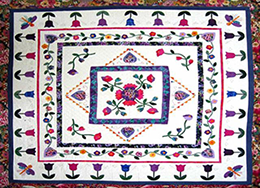How to Choose Quilt Batting
Once you have completed your quilt top, removed the pins and ironed back all the seams, it is time to choose the batting.
Batting, padding or wadding is the “bulk” of the quilt, and is the middle component of the quilt sandwich. It comes in different thicknesses, composition and texture. There is a variety of batting available, ranging from natural fibres like cotton and wool, to synthetics and man-made fabric.
- Cotton - Cotton batting is idea for beginners and small projects. Cotton is natural and easy to work with, and you are often more able to achieve a more even look using it.
- Polyester - Polyester batting is lightweight and inexpensive. It packs well and will add puffiness to your quilt. Polyester has the tendency to “beard” (work its way out through the weave of the fabric) more than natural fibres.
- Wool - Wool is very warm, absorbs moisture and is idea to be used in cool and damp climates. It is significantly flatter than unnatural fibres, however looks fantastic when quilted. Be very careful when washing and caring for you wool quilt – always read instructions or ask someone if you are not sure, as it can easily warp and change the look of your quilt.
Consider the thickness of the batting
A thin light weight batting is ideal for a quilt as it is easier to sew compared to thick heavy batting. As it is very important to produce small, even stitches over the whole quilt, it is much easier if the needle and thread only have to go through a thin piece of batting.
If you are making the quilt for a bed and would like to use it for warmth then you can use a thicker batting, however it would probably be a lot easier if it was tied rather than quilted.
Check the size of the batting
The quilt batting should be bigger than the quilt top and smaller than the backing. Leaving a small amount of overlap allows for any pull or if you find that once the quilt has been sewn the edge has moved in a couple of centimetres. When quilting it is always better to be safe rather than sorry!
If you have some left over batting from previous quilts it is possible to combine them and make a mixed piece. This process is also used for very large quilts.
Simply lay out the left-over strips and carefully tack them together using a very loose stich. (Note: they do still need to be of decent size. For example, you could join about 4 large pieces to form a single bed quilt. Any smaller than this and it would be very fiddly to work with and you run the risk of possibly having a “thin” section). Do not overlap the batting as it will give you double thickness and be much more difficult to quilt!
| Previous: Assembling the Quilt Top | Next: Choosing Quilt Backing and Binding |

